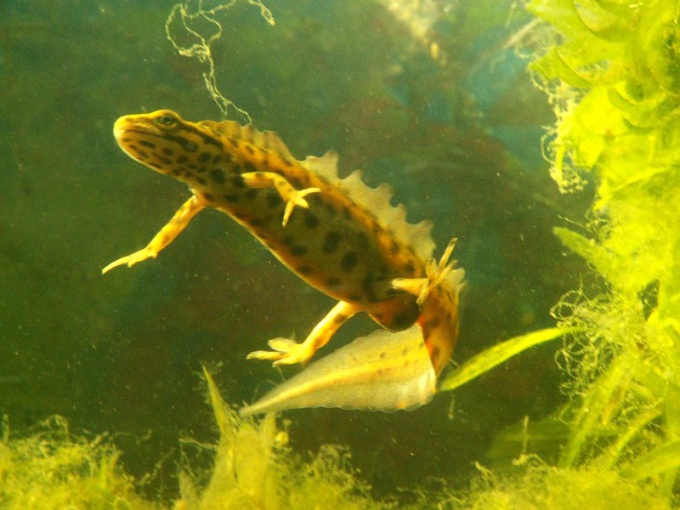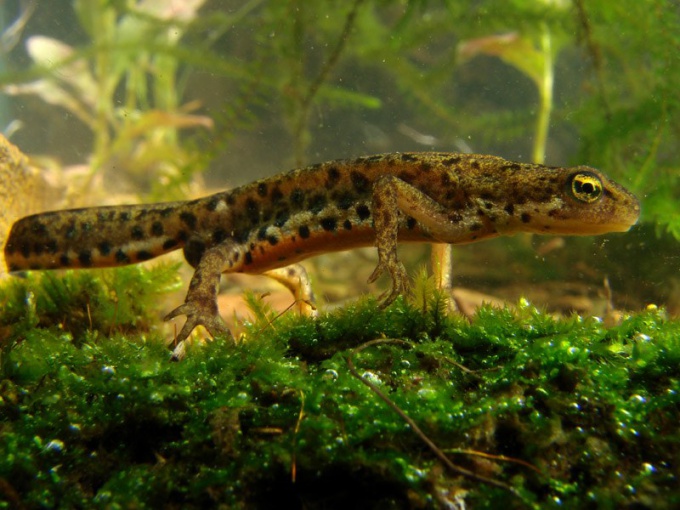What you need to know about the content of Spanish newts
What you need to know about the content of Spanish newts
Lovers of exotic animals can tryKeep at home the Spanish newt. This rather unpretentious species of amphibians lives perfectly in medium-sized aquariums with water at room temperature. The Spanish newt peacefully coexists with active schooling fish and small crustaceans.

Spanish Triton, Newt Triton, TritonRibbed - these are different names of one animal. The first name comes from the area of natural residence of this species of Triton - Spain. It also occurs in Portugal and in Morocco. Two other names appeared due to the sharp tubercles on the sides of the newt, appearing at the moment of danger. They serve as protection against predation attacks. The adult Spanish newt in nature reaches a size of up to 30 cm, along with the tail. In captivity, it usually does not grow more than 20 cm. Moreover, females are larger than males both in length and width. Sex differences are limited only by body size. The color of the Spanish newt is grayish-brown with gray spots. There are newts of brown and gray-green shades.
Arrangement of an aquarium
The Spanish newt can be kept in aquariums andAquaterariums. This animal is a cold-blooded amphibian, so the conditions for it must be appropriate. For one specimen of the Spanish newt, aquaria are suitable, with a volume of 30-40 liters, for a pair - 50 liters. The bottom is laid with a soil of smooth pebbles of medium size, so that the newt can not swallow them by accident. Triton loves shelter, so the aquarium is densely planted with living and artificial plants, adorned with snags, clay or coconut caves. The aquarium should be equipped with a filter, aeration, and lighting is required only by plants. The Spanish newt is unpretentious, so it can withstand a range of water temperatures from 15 to 27oC. But the optimal temperature for it is 20 ° C. Therefore, sometimes it is necessary to cool the water with ice bottles or fans. For a newt it is better to install in the aquarium a so-called "island of sushi". For this, a snag wrapped in moss is attached to the wall of the aquarium. Its upper edge should barely reach the surface of the water, so that the newt can climb the snag and poke its head out of the water. In this case, it is necessary to have a lid of the aquarium, because the newts tend to run.Nutrition of the Spanish newt
Adult newts are fed in 2-3 days, young- Every day. The peculiarity of feeding newts is that they need to offer food during the meal until they themselves refuse to eat, that is, "before dumping." Spent newts eat earthworms, flies, bloodworm in any form, small pieces of fresh meat (Chicken, beef). To prevent contamination of water, food should be served one by one with tweezers.Triton features
Tritons have a unique gift of regeneration. If they have bitten off a limb in the process of fighting or attack, then a new one grows in this place after a while. For amphibians, the skin plays a major role in breathing, it is through it that the tritons absorb oxygen dissolved in water. Therefore, newts often moult. Skin is torn on the head, and the newt quickly gets out of it. Then the old skin is immediately eaten. For large neighbors, large fish do not fit the triton, from which it can suffer small fishes, which immediately become its prey. The Spanish newt coexists well with schooling fish of medium size - barbs, danios, corridors and freshwater shrimps.








